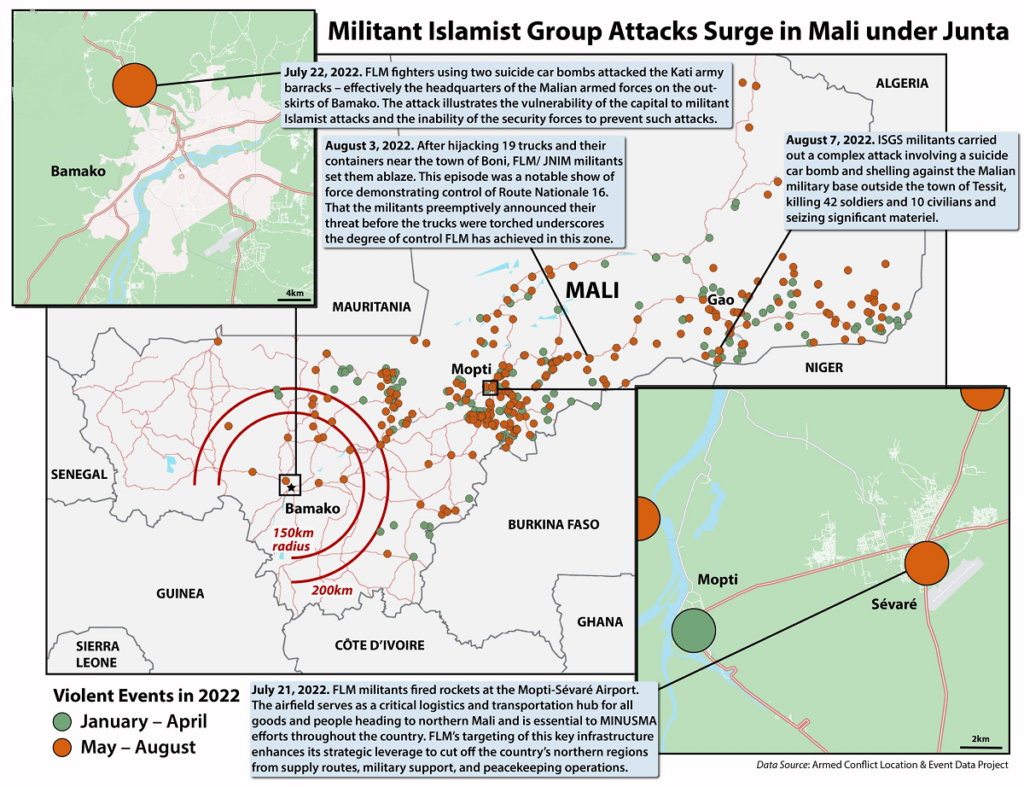
Militant Islamist group violence is accelerating in Mali, advancing a complex insurgency in north, central, and increasingly southern Mali that further threatens the country’s stability.
The security situation in Mali has deteriorated sharply since the military junta seized power in August 2020. Militant Islamist groups are now actively threatening Bamako.
This acceleration in militant Islamist group violence can be seen over both time and territory. Regarding time, extremist violence has been worse in every quarter since the military coup than in any quarter prior to the junta taking control.
Fatalities linked to militant Islamist violence in 2022 have already surpassed those of any previous year and are projected to increase by nearly 150 percent from 2021.
Civilians have borne the brunt of this violence. Militant Islamist groups have killed roughly three times as many people in violence against civilians during 2022 than in 2021. There have been more civilian fatalities in each of the first two quarters of 2022 than in any previous calendar year.
Militant Islamist-related violence has been stepping up over the course of 2022. There have been 20 percent more violent events involving militant Islamist groups during the period from May to August than the first four months of the year.The surge in militant Islamist violence in Mali is also marked by its geographic spread. The Macina Liberation Front (FLM), part of the Jama’at Nusrat al Islam wal Muslimin (JNIM) coalition of militant Islamist groups, has been the driving actor behind the surge in violence in Mali’s southern and central regions.
Southern Mali (Bamako, Kayes, Koulikoro, and Sikasso regions)
FLM has launched 9 attacks within 150 kms of Bamako in 2022—all between May and August. This is nearly double the number of such events in all of 2021. At this pace, the projected 15 violent incidents around Bamako will exceed the dozen events this zone has experienced over the five previous years combined.
FLM’s aggressive push into southern Mali has exposed Bamako’s vulnerability. Mali’s southern zone—its most densely populated area, comprising more than 60 percent of the country’s population—had been spared much of the militant Islamist violence of the past decade.
The attack on Mali’s preeminent military barracks in Kati in July carries both symbolic and operational import. These barracks are the headquarters of the Malian armed forces, with a residence maintained by junta leader Colonel Assimi Goïta. The base is also situated at a strategic intersection on the northern edge of the capital only 10 kilometers from the presidential palace.Central Mali (Mopti and Segou regions)
More than half of all militant Islamist violent events in Mali in 2022 have taken place in Central Mali. The pace of this violence has also been accelerating with 45 percent more violent events in Central Mali between May through August, than the first four months of the year.
The Mopti-Sévaré urban center is a strategic gateway for logistics and transportation between southern and northern Mali. FLM attacks on key targets in this region have enhanced its control over this vital territory, elevating its leverage over other parts of the country. These attacks include key infrastructure such as the Mopti airport—a logistics hub for the military and the United Nations Multidimensional Integrated Stabilization Mission in Mali (MINUSMA).
FLM’s control over major thoroughfares like Route Nationale 16, which connects Sévaré to Gao, has allowed FLM, at times, to cut off transportation to much of northern Mali. As evidence of this control and impunity, on August 3, FLM shut down this route and burned 19 semi-trucks around the town of Boni.Northern Mali (Gao, Kidal, Menaka, Taoudenit, and Tombouctou regions)
Northern Mali also has experienced escalating violence in 2022, though at the hands of the Islamic State in the Greater Sahara (ISGS). After suffering setbacks as a result of joint Malian, French, and Sahel G5 operations during 2020 and 2021, ISGS has been able to reassert itself following the drawdown and departure of French and G5 forces—at the behest of the Malian junta.
ISGS-led violence has subsequently surged in Gao and Menaka regions in 2022, resulting in more than 1,000 fatalities or roughly 40 percent of all fatalities in Mali this year. More than half of those killed in these attacks have been civilians massacred as ISGS seeks to reestablish its control over the area through intimidation.
Emblematic of the weakened security presence, ISGS has also targeted military positions in northern Mali. During an attack on a military base in Tessit near the borders of Burkina Faso and Niger in August, ISGS fighters overran the base, killed dozens of soldiers, and seized vehicles, weapons, and ammunition.